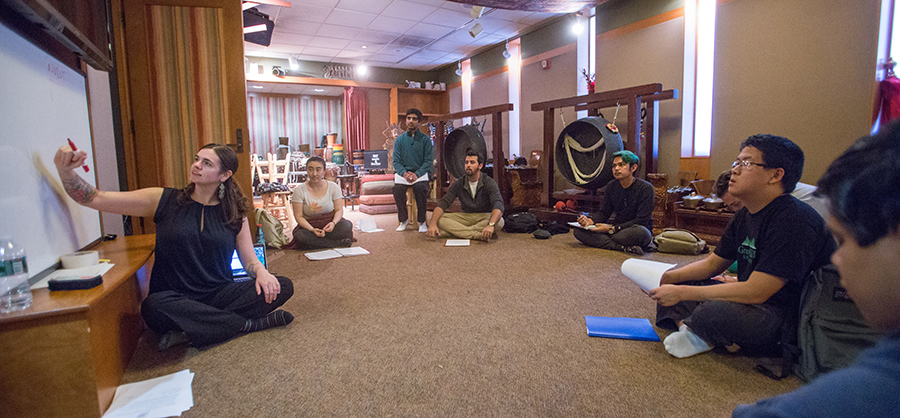Ethnomusicologist and music analyst Leslie Tilley loves the idea of blurring genres and appreciating the beauty in all music.
"There are engaging things to find in any style of music. I'm constantly surprised by what you can do with music, and that is my favorite thing: to continue being surprised," says Tilley, an associate professor of music at MIT. "Music is endlessly creative."
But what about her personal music tastes?
"That's the hardest question you can ask a musician," says Tilley, laughing.
"I will listen to anything," she says. "My alarm clock this morning was Dvorak's Cello Concerto, and then I went for a walk listening to Bad Bunny. I nerd out listening to flamenco music, and then I talk to people about gamelan."
Straddling the borders of music research
Tilley's own musical playlist is as expansive as the scope of her ethnographic research, which examines the inherent processes and unspoken guidelines governing improvisation. Through her research, Tilley is doing her part to break down barriers within the field. Tilley was recently awarded the prestigious Emerging Scholar Award by the Society for Music Theory for her book "Making It Up Together: The Art of Collective Improvisation in Balinese Music and Beyond." The honor is of particular note given that Tilley is not a music theorist.
"Because I'm an ethnomusicologist who does music analysis, which is a smaller group of ethnomusicologists, I've always felt like I'm straddling the borders," she says.
That is why she says this particular award is so gratifying - not just for the recognition of her work, but because of what it says about the walls coming down within the world of music research.
"That music theory decided to give an award to an ethnomusicologist who's studying Balinese music, and using lots of Balinese and Indonesian music and ideas, it says really cool things about what's happening in the field and how the divisions are fading, or being broken down by lots of scholars, not just me," she says. "There are lots of people straddling the borders of these different sub-fields."
Tilley's book was published in 2019, and was the culmination of years of research.
"The book is about creating language so that people who study different improvised traditions can have a unified framework to talk about them, which didn't exist before," she adds.
Tilley says as she was writing the book, it took her in directions she didn't expect.
"What I learned was just where all the intersections are if you zoomed the lens back a little bit more," she says. "That there are all these amazing scholarly intersections where I know people who are writing about literature or people who are writing about the brain, and patterns. And all of these things can play into how I think about what musicians are doing. And that was really, really exciting for me."
Teaching 'music with a capital M'
Since joining the MIT faculty in 2015, Tilley has been sharing her passion for a diversity of musical practices with students. She has led the MIT Balinese gamelan, and teaches courses such as 21M.030 (Introduction to Musics of the World), 21M.051 (Fundamentals of Tonal Music), 21M.500 (Advanced Seminar in Music), and 21M.292 (Musics in Bali). Tilley says she designed her course 21M.053 (Rhythms of the World) as a re-imagined fundamentals of music course that explores musical concepts as cross-cultural and cross-genre phenomena: a chance for students to learn about "music with a capital M."

Previous item Next item
"One hundred percent of the people in the world engage with music in some way," she says. "And so, (students) all come with their own expertise. In a class like Rhythms of the World, where there's not a specific tradition that I'm teaching them about, they can bring their expertise. They can bring their own life experience into that space, and then grow from there. And then engage with other people's life experiences in ways that are very personal within music."
One of her favorite parts of teaching is when she asks students to analyze a piece of music they're interested in using the concepts and structures they've learned in Rhythms of the World.
"They're listening across the board to anything and everything you can imagine," she says. "Every semester I discover some cool new thing I didn't know before, or an interesting style of music just based on what my students are listening to."
Exploring cover songs
Tilley's current research project is a book examining cover songs. She says that while that may seem like a left turn, it's actually an extension of the research she's been doing her entire career.
"What I'm interested in is: How do people take a musical thing and do something with it, and how do we think about the transformation of that thing? How does a musician take something and transform it into something else? And how can we talk about that in useful and multifaceted ways?" she says. "Considering the music itself, considering the musicians who are making it, considering the idiom that it's coming from or going to. Considering who's receiving it and how it's being received. And how does all that play into what that transformation means?"






